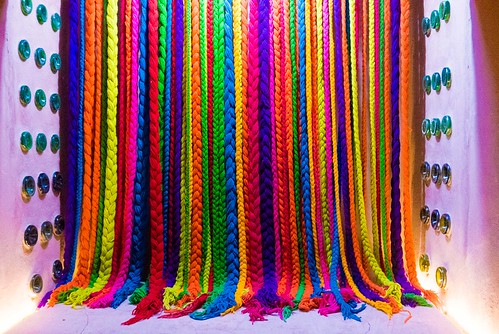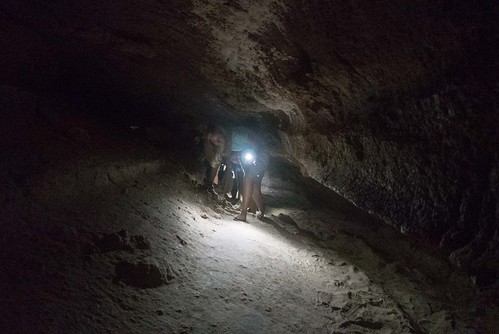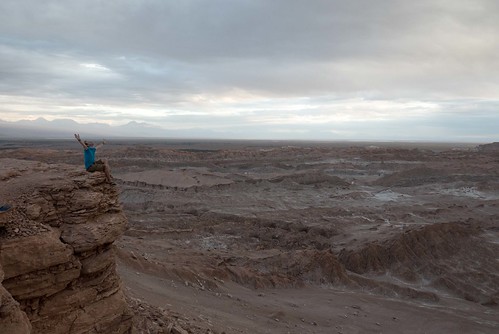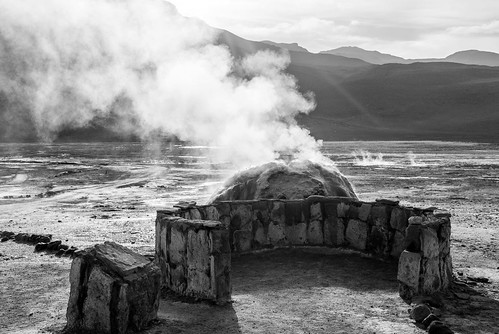A proper look around the town (population: less than 2000) the next day revealed that it's made up of four things: restaurants, hostels, souvenir shops and travel agencies. More travel agencies, in fact, that could feasibly be sustained, even by the amount of tourism San Pedro received. If there are fewer than sixty operating, I'd be surprised. Given the significant altitude, we didn't want to rush into any tours, so we instead had the best pizza we've eaten in south America so far at Pizzeria El Charrúa, followed by superb gelato at Babalu. Sara and Richard had warned us it would be hot, but we weren't expecting the intensity of the sun. The Atacama is the driest desert on earth and the water isn't potable up here, so it looks like this was the start of a month's worth of buying bottled water (as Bolivia's is even worse). And you need it: we got through four litres in a day and a half. After lunch, we set out to look at tours. Pretty much every company in town offers the same few tours: Valle de la Luna, Geysers del Tatio, Valle de Muerte, and so on. The only discernible difference we could see is the price; given the amount of competition, agencies will give you discounts for booking multiple excursions, but TripAdvisor can generally help pick out the good from the bad. We'd already booked onto the Space astronomy tour for the 8th via email (although the confusing number of replies we received made us wonder if we'd actually got a spot at all...luckily so, since they were booked out five days ahead). That left Valle de la Luna, the geysers, and sandboarding, which were the three other things we wanted to do whilst here. We'd considered cycling around Valle de la Luna but the day's heat put us firmly off the idea of a 32km round trip. Instead we booked sandboarding and the valley for the following day, and geysers for the day after alongside our night-time astronomy.



Neither of us had sandboarded or snowboarded before, so we weren't entirely sure what we were getting into when we bundled into a van the next morning. We arrived at a 170m dune soon after and realised that this was what we'd have to climb up every time we reached the bottom, since apparently the tour didn't include mules and a sedan chair to the top. After getting kitted out with boots and a board, the first walk up the dune was probably the worst. Even at 10am the temperature was hot enough to feel it, especially lugging a 1.5m board. Our instructor Sebastian gave us the basics of waxing the base with a candle and then showed us how to balance and slow down if we went too fast. Then it was over to us. My first time down the dune was slow, but I got a feel for keeping my balance. I felt much more confident on my second go and only fell over a couple of times in between covering a decent amount of ground. Maybe that's why on my third attempt I decided to hike up almost to the top of the dune and launch myself off. For the first half of the dune things were going great. I'm not entirely sure what happened after that. Perhaps I leaned forward too far, but the next thing I knew I was tumbling head over board down the dune. Thankfully I had a helmet on, as I definitely smashed my head into the ground. Looking at the video afterwards I'm not entirely sure how I didn't break my neck; Gilly was certain I had. My wipeout (and some other more sensible bits, mostly from Gilly not trying to kill herself) are below.







I somehow got out of that with just a bruised - possibly cracked - rib and a sore leg, and my fourth and final attempt was a lot more cautious. It seems crazy to pay fifteen quid for four trips down a dune, but it was totally worth it for me - near death experience notwithstanding - as not only was it good practice for Huacachina in Peru, but it made me very interested in trying snowboarding too.
After the morning's excitement, we had time for a cheap lunch at La Pica del Indio and an hour's nap before heading out to do a tour at Valle de la Luna. After a comical ten minutes where the company we bought the tour off took us to another company to actually do the tour (it seems that it doesn't really matter who you book through - they just chuck you in with whoever has spaces to fill), we got on the bus to the valley. In truth, it wasn't that impressive. The landscape definitely had an interesting feel to it, albeit one that was mainly whiteish sand and rock mixed with odd rock formations, but I think the comparison to the moon's surface is a bit of a stretch. I'm sure Buzz would agree. The amphitheatre you see along the way is a layered accordion-like formation, which is of interest to geologists if no-one else.
More laughable were the Tres Marias (Three Marys), of which only two remain after an Israeli tourist jumped on one and knocked it dodwn. Apparently they resemble Jesus's mother. Squint a lot, and you'll still not see it. It was reminiscent of the Twelve Apostles in Australia, except they didn't claim to look like Peter, Paul, et al. Hilariously, there's another formation to the left of them which does actually look like a turtle-cum-dinosaur. The distant volcanoes were stunning though, and could easily have stood in for Mordor.









After trekking along the Great Dune Path for the views over the valley, we then entered the salt mines. These were a series of canyons and caverns naturally formed which happened to make a handy route for tourists to trek through and bang their heads in appropriately dark places. Our tour operator had neglected to tell us a torch would have been useful, so instead we navigated them by the dim light of our phones and only banged our heads and backs four times.

Given the Atacama desert's lack of water (only 3mm of rain a year) it should come as no surprise that it started to rain as soon as two English people turned up... Only a few drops here and there, but it's all counting towards that 3mm average. El Nino is wreaking havoc everywhere, it seems.
The highlight of the trip was the sunset - which we almost didn't see only because our driver was in a rush to get home. After pleading with the guide to make him see sense, he relented and we managed to get five minutes to capture the blazing skies over the valley.





It wasn't a bad way to spend half a day, but like most of the tours in San Pedro it's worth shopping around to get the best price thanks to the odd cartel that seems to operate here. Go in with low expectations and hope for a decent sunset, and it'll be an enjoyable trip.
We were up crazily early (4:30am) for another tour to the Geysers del Tatio the next morning. Whilst we'd seen thermal springs and similar phenomenon in New Zealand in Rotorua, I'd never seen actual erupting geysers. It was worth braving the cold for, and I even took a dip into the hot thermal baths (well, it was more warmish but felt hot since the temperature was close to freezing at that time of the morning). Our guide was excellent, especially since we were the only two non-Spanish speakers in the group. The geyser fields were vast and marked slightly confusingly with different coloured rocks which meant absolutely nothing, a little concerning since tourists have occasionally fallen through the crust after straying from the path and died from the severe burns the scalding water inflicted.






After the geysers, we took a trip along some wetlands to spot the wildfowl in the area, before going to the small village of Machucato try some llama on a stick (verdict: pretty tasty, much better than the stew we had in Purmamarca). The village itself appeared to be set up specifically to cater to tourists, with llama photo ops and homemade crafts abounding.






We got back mid-afternoon, where more ice cream was followed by dinner at Sol Inti. Gilly found her MP3 player that evening, buried in her bag. She'd done what is known in the travelling business as a "Rob look" i.e. taking a cursory glance around for something really important, not finding it immediately, and declaring it lost forever. It saved us a trawl through the malls and markets of dodgy electronics in Bolivia, at least.
Throughout our stay in San Pedro, the main reason for staying here was to do a space observatory evening. San Pedro is one of the best places in the world to do stargazing, since the light pollution is minimal. However, despite having booked in on the night of the new moon, we were then told that the weather looked like it may be too cloudy so they were unsure if it would go ahead. Obviously, clouds are not conducive to seeing stars, so we had an anxious wait all afternoon and evening, right until the 8:30pm deadline, when we were told that it was definitely going ahead. We bundled into a bus and got taken to the home of Alain Maury, a French astronomer who has discovered 7 asteroids and also had comets named after him. There were around twenty of us in the group, and he spent the first hour or so with us just standing in a circle in the garden, whilst he gave us a basic overview of astronomy which was littered with interesting facts and accompanied by his insane light pointer which he could use to pick out stars and constellations in the sky. It was quite simply breathtaking - both the sky, and his knowledge - and it also helped that he was hilarious; if he ever decided on a change of career, stand-up comedy has to be high on the agenda.
After the introduction, he showed us around the ten telescopes in his garden. Each of them pointed at different things, whether it was the Magellan Cluster, twinkling stars which glowed blue-red-green due to atmospheric dust, or Jupiter itself. My photo attempts weren't wholly successful, but Jupiter is the bright white blob in the first photo. The telescopes were super powerful - one which Alain had built himself would normally cost around $250,000 but he made it for a tenth of that price by purchasing the lens off eBay!


After we'd been around the telescopes a few times, we went into a cosy little wooden hut for hot chocolate, while Alain talked to us about asteroids and the various levels of impact they have on the earth. According to him, we're not likely to experience a world-altering impact during our lifetime, and since he used to assist NASA in tracking them, I'm taking that as a safe assertion. The three hours in his company were the highlight of San Pedro for us, as well as being a highlight of the trip. I'd urge anyone with even the vaguest interest in knowing not just about stars, but also the insignificance of our time on this planet, to check out the Space Obs evening.
Our last day was a quiet one - we changed some pesos to Bolivianos, had an average, over-priced meal at Adobe, and booked onto the 3 day salt flats tour at Salar de Uyuni. We'd had so many different reviews and suggestions for companies that our heads were spinning, but in the end we opted for World White Travel since TripAdvisor folk seemed to be pretty happy with them. It was unlikely we'd get a Spanish guide, but as long as we got to see the flats, I'd be happy. It was the end of our time in Chile, and we'd soon be crossing into Bolivia - a country which was allegedly the cheapest in South America to travel around. Time would tell!
No comments:
Post a Comment